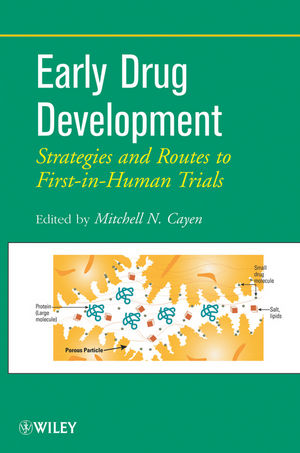Early Drug Development: Strategies and Routes to First-in-Human TrialsISBN: 978-0-470-17086-1
Hardcover
654 pages
August 2010
 This is a Print-on-Demand title. It will be printed specifically to fill your order. Please allow an additional 10-15 days delivery time. The book is not returnable.
|
||||||
Foreward.
Preface.
PART I INTRODUCTION.
1 Drug Discovery and Early Drug Development (Mitchell N. Cayen).
1.1 The Drug Discovery and Development Scene.
1.2 Drug Discovery.
1.3 Pre-FIH Drug Development.
1.4 The FIH Trial.
1.5 The Regulatory Landscape.
1.6 Contract Research Organizations.
1.7 Concluding Remairs to Introductory Perspectives.
References.
PART II LEAD OPTIMIZATION STRATEGIES.
2 ADME Strategies in Lead Optimization (Amin A. Nomeir).
2.1 Introduction.
2.2 Absorption.
2.3 Distribution.
2.4 Metabolism.
2.5 Excretion.
2.6 Pharmacokinetics.
2.7 Prioritizing ADME Screens.
2.8 In Silico ADME Screening.
2.9 The Promise of Metabolomics.
2.10 Conclusions.
References.
3 Prediction of Pharmacokinetics and Drug Safety in Humans (Peter L. Bullock).
3.1 Introduction.
3.2 Prediction of Human Pharmacokinetic Behavior.
3.3 Prediction of Drug Safety.
3.4 Conclusions.
References.
4 Bioanalytical Strategies (Christopher Kemper).
4.1 Introduction.
4.2 Basic Bioanalytical Techniques and Method Development.
4.3 Bioanalytical Method Validation.
4.4 Special Issues with Ligand-Binding Assays.
4.5 Partial and Cross-Validations.
4.6 Application of Validated Methods to Sample Analyses: Some Perspectives.
4.7 Risk-Based Paradigms: Discovery and Development Support.
4.8 Road to "First in Human".
4.9 International Perspectives.
4.10 Conclusions.
References.
PART III BRIDGING FROM DISCOVERY TO DEVELOPMENT.
5 Chemistry, Manufacturing and Controls: The Drug Substance and Formulated Drug Product (Örn Almarsson and Christopher J. Galli).
5.1 Introduction.
5.2 Pre-NCE Activities and CMC Development.
5.3 CMC Consideration at the NCE Stage.
5.4 NCE-to-GLP Transition (Bridging from Discovery to Pre-FIH Development).
5.5 CMCs to Meet Clinical Trial Material Requirements.
5.6 CMC Strategic Considerations.
5.7 Case Studies.
5.8 Evolution of Drug Development: Implications for CMCs in the Future.
Resources.
References.
6 Nonclinical Safety Pharmacology Studies Recommended for Support of First-in-Human Clinical Trials (Duane B. Lakings).
6.1 Introduction and Overview.
6.2 Timing of Safety Pharmacology Studies.
6.3 CNS Safety Pharmacology.
6.4 Cardiovascular Safety Pharmacology.
6.5 Respiratory System Safety Pharmacology.
6.6 Renal/Urinary Safety Pharmacology.
6.7 Gastrointestinal System Safety Pharmacology.
6.8 Autonomic Nervous System Safety Pharmacology.
6.9 Other Systems.
6.10 Discussion and Conclusion.
References.
PART IV PRE-IND DRUG DEVELOPMENT.
7 Toxicology Program to Support Initiation of a Clinical Phase I Program for a New Medicine (Hugh E. Black, Stephen B. Montgomery and Ronald W. Moch).
7.1 Introduction.
7.2 Toxicology Support of Discovery.
7.3 Goals of the Pre-FIH Toxicology Program.
7.4 Importance of a Clinical Review of the Nonclinical Pharmacology Data.
7.5 Take the Time to Plan Appropriately.
7.6 The Active Pharmaceutical Ingredient.
7.7 Timely Conduct of In Vitro Assays.
7.8 Development of Validated Bioanalytical and Analytical Assays.
7.9 Planning for the Conduct of Toxicity Studies.
7.10 GLP Toxicology Program.
7.11 Pre-IND Meeting.
7.12 Conclusion.
References.
8 Toxicokinetics in Support of Drug Development (Gary Eichenbaum, Vangala Subrahmanyam and Alfred P.Tonelli).
8.1 Introduction.
8.2 Historical Perspectives.
8.3 Regulatory Considerations.
8.4 Factors to Consider in the Design of Toxicokinetic Studies.
8.5 Toxicokinetic Parameter Estimates and Calculations.
8.6 Interpretation of Toxicokinetic Data.
8.7 Role of Toxicokinetics in Different Types of Toxicity Studies.
8.8 Role of Toxicokinetics in Integrated Safety Assessment.
8.9 Conclusion.
References.
9 Good Laboratory Practices (Anthony B. Jones, Kathryn Hackett-Fields and Shari L. Perlstein).
9.1 Introduction.
9.2 Hazard and Risk.
9.3 US GLP Regulations.
9.4 GLPs in the Bioanalytical Laboratory.
9.5 Moving Into the Future: A Closing Overview.
9.6 Appendixes.
References.
PART V PLANNING THE FIRST-IN-HUMAN STUDY AND REGULATORY SUBMISSION.
10 Estimation of Human Starting Dose for Phase I Clinical Programs (Lorrene A. Buckley, Parag Garhyan, Rafael Ponce and Stanley A. Roberts).
10.1 Introduction.
10.2 Characteristics of Well-Behaved Therapeutic Candidates.
10.3 Regulatory Guidances for FIH-Enabling Preclinical Safety Assessment: General Principles.
10.4 Nonclinical Pharmacokinetics and Pharmacodynamics for Human Dose Projection.
10.5 Establishing the First-in-Human Dose.
10.6 Phase I Clinical Trial Support: Use of MABEL or Pharmacologically Active Dose.
10.7 Support of Exploratory Clinical Studies.
10.8 Considerations in the Design of Phase I Trials.
10.9 Interdisciplinary Partnerships.
10.10 Beyond the FIH Dose.
10.11 Concluding Perspective.
10.12 Four Case Studies.
References.
11 Exploratory INDs/CTAs (Mitchell N. Cayen).
11.1 Introduction.
11.2 Regulatory Background.
11.3 Experience and Various Perspectives on ExpINDs or ExpCTAs.
11.4 Some Reactions and Perspectives on the ExpIND/ExpCTA Initiative.
11.5 What Is an Ideal Candidate for an ExpIND/ExpCTA?
11.6 Conclusions.
References.
12 Unique Considerations for Biopharmaceutics (Laura P. Andrews and James D. Green).
12.1 Introduction and Background.
12.2 Selection of the Molecule: Contrasts to Small-Molecule Considerations.
12.3 Production and Process Considerations in Pre-FIH Development.
12.4 Bioanalytical Assay Considerations.
12.5 Objectives and Implementation of Pre-FIH Safety Assessment Programs.
12.6 Post-IND Considerations: Support of Phase II and III and Registration.
12.7 The TeGenero Incident and Implications for Biopharmaceutic Nonclinical Safety Evaluation Programs.
12.8 Conclusions.
References.
13 Project Management and International Regulatory Requirements for First-in-Human Trials (Carolyn D. Finkle and Judith Atkins).
13.1 Introduction: Initiate Product Development with the End in Mind.
13.2 Importance of Project Management.
13.3 FDA Input Early and Often.
13.4 IND Submission in the United States.
13.5 Global Clinical Trials.
13.6 Clinical Trial Application.
13.7 Conclusion.
References.
14 First-in-Human Regulatory Submissions (Mary Sommer, Mark Ammann, Ulf B. Hillgren, Kathleen J. Kovacs and Keith Wilner).
14.1 Introduction.
14.2 Submission Strategies.
14.3 First-in-Human Dossiers.
14.4 United States: Investigational New Drug Application.
14.5 European Union: Clinical Trial Application.
14.6 Japan: Clinical Trial Protocol Notification.
14.7 Emerging Regions.
14.8 Biopharmaceuticals.
14.9 Final Considerations.
Appendix 1: Abbreviations and Acronyms.
Appendix 2: Definitions and Glossary of Terms.
Appendix 3: Some Relevant Government and Regulatory Documents.
Appendix 4: Some Relevant Resources with Web Sites.
Index.



